记录|深度学习100例-卷积神经网络(CNN)天气识别 | 第5天
这篇博客将从构建自己的天气数据集开始,到定义模型,编译模型,训练模型及验证模型。并进行一些升级,以使得模型更好。
如ImageDateGenerator进行数据增强,之后分别对cloudy,haze,sunrise,shine,snow,rain,thunder等7种天气情况进行识别。
准确率75%不是太高(可能是因为原始数据集的原因,每个分类有4种),可以通过增加原始数据解决。
1. 效果图
原始数据集:
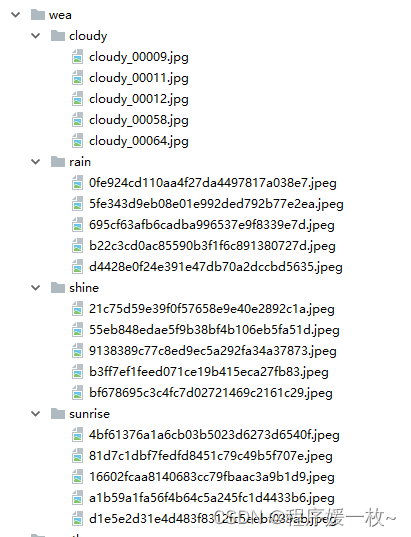
预处理后数据集:(修改了图片名称,调整为固定大小)
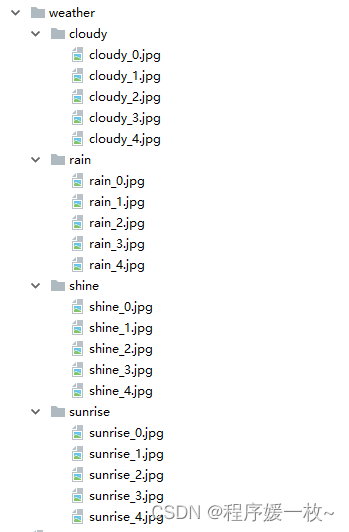
原始训练集图如下:
共20张(rain,cloudy,sunrise,shine各5张),以0.2拆分表示:16张用于训练,4张用于测试。
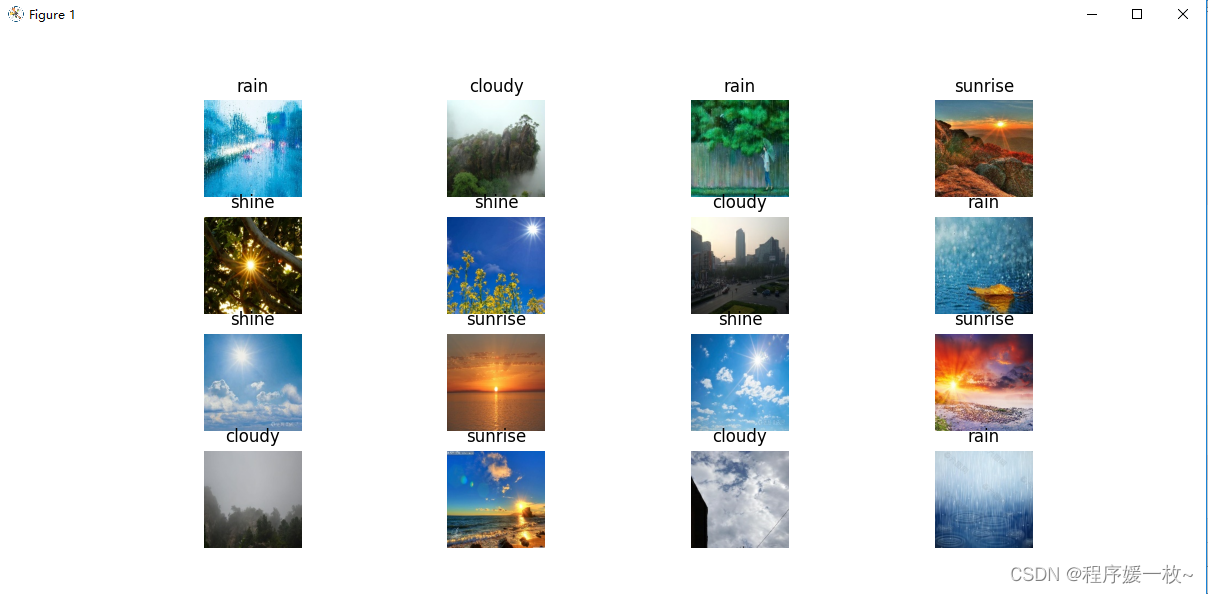
可以看到验证集的图片均成功预测:
title:真实值
pre:预测结果
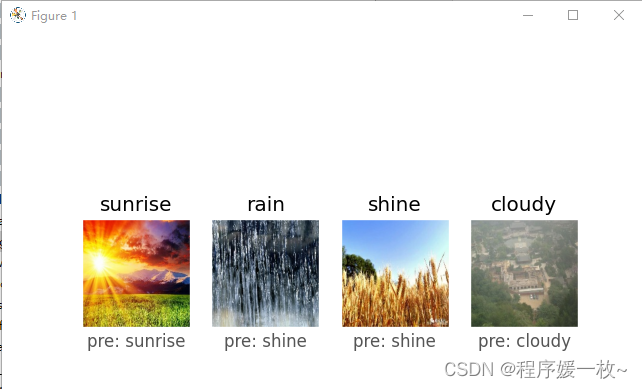
训练损失/精确度如下:
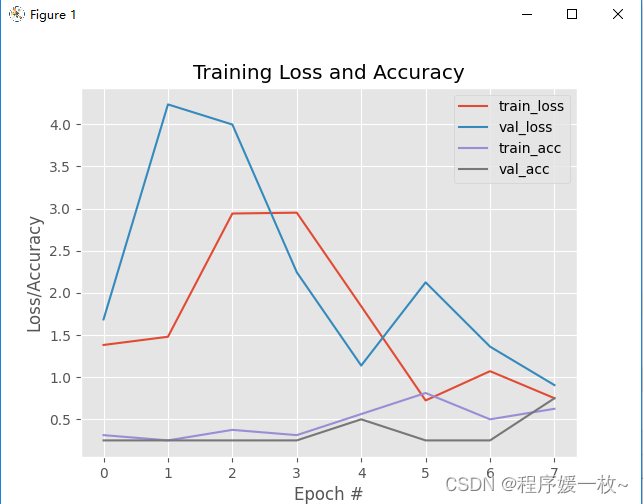
优化1:数据增强后损失/准确度图:
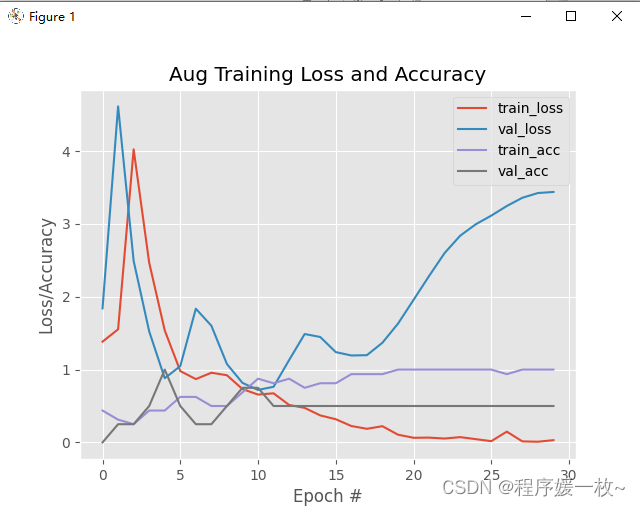
可以看到准确度有提高。
优化2: 数据扩展到并进行数据增强:
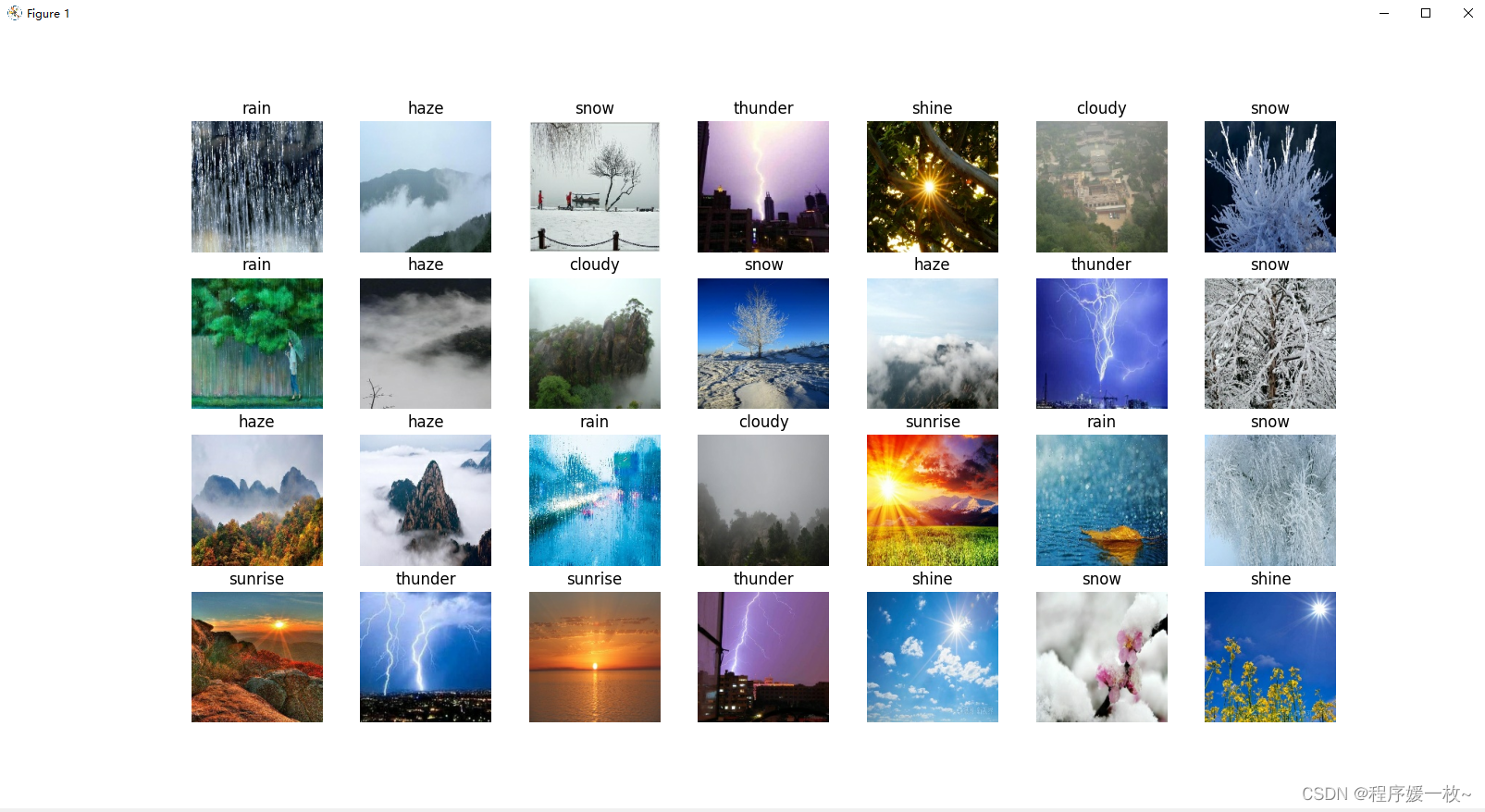
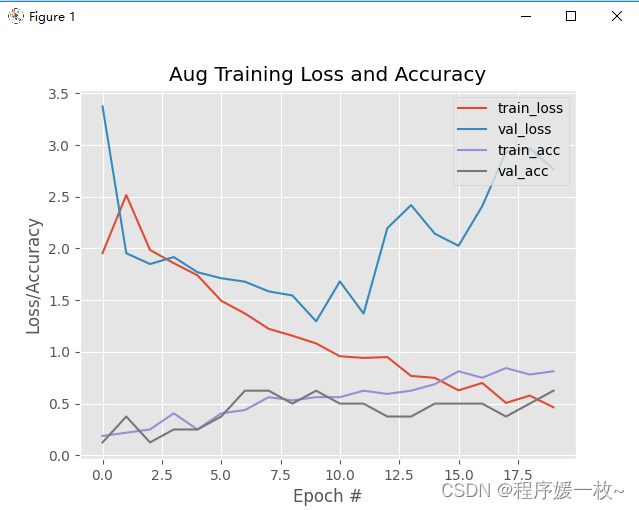
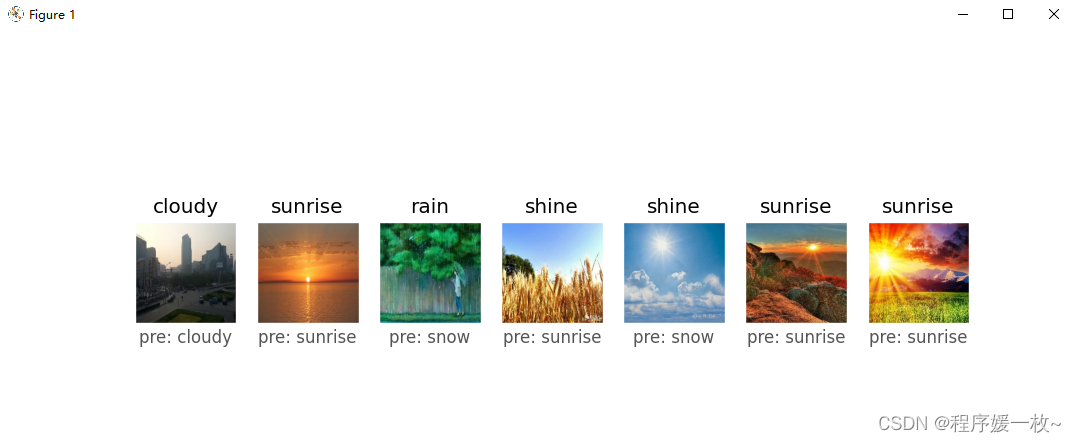
2. 源码
2.1 图像预处理源码
# 图像预处理(改名/缩放原图像文件)
# USAGE
# python preprocess_img.py
import os
import cv2
from imutils import paths
imagePaths = sorted(list(paths.list_images("weather\\")))
for num, i in enumerate(imagePaths):
src = i
print(num, i)
print(str(i.split(os.path.sep)[-2]), str((num + 1) % 5),
"weather\\" + str(i.split(os.path.sep)[-2]) + os.path.sep +
str(i.split(os.path.sep)[-2]) + "_" + str((num + 1) % 5) + ".jpg")
dst = "weather\\" + str(i.split(os.path.sep)[-2]) + os.path.sep + str(i.split(os.path.sep)[-2]) + "_" + str(
(num + 1) % 5) + ".jpg"
# 改名,缩放源文件
try:
os.rename(src, dst=dst)
print('converting %s to %s ...' % (src, dst))
except:
continue
img = cv2.imread(dst)
cv2.imwrite(dst, cv2.resize(img, (180, 180)))
2.2 训练及验证数据源码
# 深度学习100例-卷积神经网络(CNN)天气识别 | 第5天
# usage
# python img_weather5.py
import pathlib
import matplotlib.pyplot as plt
import numpy as np
import tensorflow as tf
from tensorflow.keras import layers, models
gpus = tf.config.list_physical_devices("GPU")
if gpus:
gpu0 = gpus[0] # 如果有多个GPU,仅使用第0个GPU
tf.config.experimental.set_memory_growth(gpu0, True) # 设置GPU显存用量按需使用
tf.config.set_visible_devices([gpu0], "GPU")
# 设置随机种子尽可能使结果可以重现
np.random.seed(1)
# 设置随机种子尽可能使结果可以重现
tf.random.set_seed(1)
# 此处可以为绝对路径/也可以为相对路径
# data_dir = "E:/mat/py-demo-22/220807/weather/"
data_dir = "weather/"
# 数据集一共分为cloudy、rain、shine、sunrise
data_dir = pathlib.Path(data_dir)
image_count = len(list(data_dir.glob('*/*.jpg')))
print("图片总数为:", image_count)
batch_size = 32
img_height = 180
img_width = 180
"""
关于image_dataset_from_directory()的详细介绍可以参考文章:https://mtyjkh.blog.csdn.net/article/details/117018789
返回的是data = tf.data.Dataset
"""
# 使用image_dataset_from_directory()将数据加载到tf.data.Dataset中
train_ds = tf.keras.preprocessing.image_dataset_from_directory(
data_dir,
validation_split=0.2, # 验证集0.2
subset="training",
seed=123,
image_size=(img_height, img_width),
batch_size=batch_size)
"""
关于image_dataset_from_directory()的详细介绍可以参考文章:https://mtyjkh.blog.csdn.net/article/details/117018789
"""
val_ds = tf.keras.preprocessing.image_dataset_from_directory(
data_dir,
validation_split=0.2,
subset="validation",
seed=123,
image_size=(img_height, img_width),
batch_size=batch_size)
class_names = train_ds.class_names
print(class_names)
# 可视化
plt.figure(figsize=(16, 8))
for images, labels in train_ds.take(1):
for i in range(16):
ax = plt.subplot(4, 4, i + 1)
# plt.imshow(images[i], cmap=plt.cm.binary)
plt.imshow(images[i].numpy().astype("uint8"))
plt.title(class_names[labels[i]])
plt.axis("off")
plt.show()
# 再次检查数据
for image_batch, labels_batch in train_ds:
print(image_batch.shape)
print(labels_batch.shape)
break
AUTOTUNE = tf.data.AUTOTUNE
# 将数据集缓存到内存中,加快速度
train_ds = train_ds.cache().shuffle(1000).prefetch(buffer_size=AUTOTUNE)
val_ds = val_ds.cache().prefetch(buffer_size=AUTOTUNE)
num_classes = 4
"""
关于卷积核的计算不懂的可以参考文章:https://blog.csdn.net/qq_38251616/article/details/114278995
layers.Dropout(0.4) 作用是防止过拟合,提高模型的泛化能力。
在上一篇文章花朵识别中,训练准确率与验证准确率相差巨大就是由于模型过拟合导致的
关于Dropout层的更多介绍可以参考文章:https://mtyjkh.blog.csdn.net/article/details/115826689
"""
# 为了增加模型的泛化能力,增加了Dropout层,并将最大池化层更新为平均池化层
model = models.Sequential([
layers.experimental.preprocessing.Rescaling(1. / 255, input_shape=(img_height, img_width, 3)),
layers.Conv2D(16, (3, 3), activation='relu', input_shape=(img_height, img_width, 3)), # 卷积层1,卷积核3*3
layers.AveragePooling2D((2, 2)), # 池化层1,2*2采样
layers.Conv2D(32, (3, 3), activation='relu'), # 卷积层2,卷积核3*3
layers.AveragePooling2D((2, 2)), # 池化层2,2*2采样
layers.Conv2D(64, (3, 3), activation='relu'), # 卷积层3,卷积核3*3
layers.Dropout(0.3),
layers.Flatten(), # Flatten层,连接卷积层与全连接层
layers.Dense(128, activation='relu'), # 全连接层,特征进一步提取
layers.Dense(num_classes) # 输出层,输出预期结果
])
model.summary() # 打印网络结构
# 设置优化器
opt = tf.keras.optimizers.Adam(learning_rate=0.001)
model.compile(optimizer=opt,
loss=tf.keras.losses.SparseCategoricalCrossentropy(from_logits=True),
metrics=['accuracy'])
EPOCHS = 8
history = model.fit(
train_ds,
validation_data=val_ds,
epochs=EPOCHS
)
for images_test, labels_test in val_ds:
continue
# 画出训练精确度和损失图
N = np.arange(0, EPOCHS)
plt.style.use("ggplot")
plt.figure()
plt.plot(N, history.history["loss"], label="train_loss")
plt.plot(N, history.history["val_loss"], label="val_loss")
plt.plot(N, history.history["accuracy"], label="train_acc")
plt.plot(N, history.history["val_accuracy"], label="val_acc")
plt.title("Training Loss and Accuracy")
plt.xlabel("Epoch #")
plt.ylabel("Loss/Accuracy")
plt.legend(loc='upper right') # legend显示位置
plt.show()
test_loss, test_acc = model.evaluate(val_ds, verbose=2)
print(test_loss, test_acc)
# 优化2 输出在验证集上的预测结果和真实值的对比
pre = model.predict(val_ds)
for images, labels in val_ds.take(1):
for i in range(4):
ax = plt.subplot(1, 4, i + 1)
plt.imshow(images[i].numpy().astype("uint8"))
plt.title(class_names[labels[i]])
plt.xticks([])
plt.yticks([])
# plt.xlabel('pre: ' + class_names[np.argmax(pre[i])] + ' real: ' + class_names[labels[i]])
plt.xlabel('pre: ' + class_names[np.argmax(pre[i])])
print('pre: ' + str(class_names[np.argmax(pre[i])]) + ' real: ' + class_names[labels[i]])
plt.show()
print(labels_test)
print(labels)
print(pre)
print(pre.argmax(axis=1))
print(class_names)
from sklearn.metrics import classification_report
# 优化1 输出可视化报表
print(classification_report(labels_test,
pre.argmax(axis=1), target_names=class_names))
2.3 升级版+数据增强训练及验证数据源码
# 深度学习100例-卷积神经网络(CNN)天气识别 | 第5天
# usage
# python img_weather5_aug.py
import pathlib
import matplotlib.pyplot as plt
import numpy as np
import tensorflow as tf
from tensorflow.keras import layers, models
# 将使用ImageDataGenerator扩充数据。建议使用数据扩充,这样会导致模型更好地推广。
# 数据扩充涉及对现有训练数据添加随机旋转,平移,剪切和缩放比例。
from tensorflow.keras.preprocessing.image import ImageDataGenerator
gpus = tf.config.list_physical_devices("GPU")
if gpus:
gpu0 = gpus[0] # 如果有多个GPU,仅使用第0个GPU
tf.config.experimental.set_memory_growth(gpu0, True) # 设置GPU显存用量按需使用
tf.config.set_visible_devices([gpu0], "GPU")
# 设置随机种子尽可能使结果可以重现
np.random.seed(1)
# 设置随机种子尽可能使结果可以重现
tf.random.set_seed(1)
# 此处可以为绝对路径/也可以为相对路径
# data_dir = "E:/mat/py-demo-22/220807/weather/"
data_dir = "weather/"
# 数据集一共分为cloudy、rain、shine、sunrise
data_dir = pathlib.Path(data_dir)
image_count = len(list(data_dir.glob('*/*.jpg')))
print("图片总数为:", image_count)
batch_size = 32
img_height = 180
img_width = 180
"""
关于image_dataset_from_directory()的详细介绍可以参考文章:https://mtyjkh.blog.csdn.net/article/details/117018789
返回的是data = tf.data.Dataset
"""
# 使用image_dataset_from_directory()将数据加载到tf.data.Dataset中
train_ds = tf.keras.preprocessing.image_dataset_from_directory(
data_dir,
validation_split=0.2, # 验证集0.2
subset="training",
seed=123,
image_size=(img_height, img_width),
batch_size=batch_size)
"""
关于image_dataset_from_directory()的详细介绍可以参考文章:https://mtyjkh.blog.csdn.net/article/details/117018789
"""
val_ds = tf.keras.preprocessing.image_dataset_from_directory(
data_dir,
validation_split=0.2,
subset="validation",
seed=123,
image_size=(img_height, img_width),
batch_size=batch_size)
class_names = train_ds.class_names
print(class_names)
# 可视化
plt.figure(figsize=(16, 8))
for images, labels in train_ds.take(1):
for i in range(16):
ax = plt.subplot(4, 4, i + 1)
# plt.imshow(images[i], cmap=plt.cm.binary)
plt.imshow(images[i].numpy().astype("uint8"))
plt.title(class_names[labels[i]])
plt.axis("off")
plt.show()
# 再次检查数据
for image_batch, labels_batch in train_ds:
print(image_batch.shape)
print(labels_batch.shape)
break
# 构建图像加强生成器
# 图像增强使我们可以通过随机旋转,移动,剪切,缩放和翻转从现有的训练数据中构建“其他”训练数据。
# 数据扩充通常是以下关键步骤:
# -避免过度拟合
# -确保模型能很好地泛化 我建议您始终执行数据增强,除非您有明确的理由不这样做。
aug = ImageDataGenerator(rotation_range=30, width_shift_range=0.1,
height_shift_range=0.1, shear_range=0.2, zoom_range=0.2,
horizontal_flip=True, fill_mode="nearest")
x = aug.flow(image_batch, labels_batch)
# 可视化
plt.figure(figsize=(16, 8))
for image_batch, labels_batch in x:
print(image_batch.shape)
print(labels_batch.shape)
break
print(x.x.shape)
for i in range(16):
ax = plt.subplot(4, 4, i + 1)
plt.imshow(x.x[i].astype("uint8"))
plt.title(class_names[labels[i]])
plt.axis("off")
plt.show()
AUTOTUNE = tf.data.AUTOTUNE
# 将数据集缓存到内存中,加快速度
train_ds = train_ds.cache().shuffle(1000).prefetch(buffer_size=AUTOTUNE)
val_ds = val_ds.cache().prefetch(buffer_size=AUTOTUNE)
num_classes = 4
"""
关于卷积核的计算不懂的可以参考文章:https://blog.csdn.net/qq_38251616/article/details/114278995
layers.Dropout(0.4) 作用是防止过拟合,提高模型的泛化能力。
在上一篇文章花朵识别中,训练准确率与验证准确率相差巨大就是由于模型过拟合导致的
关于Dropout层的更多介绍可以参考文章:https://mtyjkh.blog.csdn.net/article/details/115826689
"""
# 为了增加模型的泛化能力,增加了Dropout层,并将最大池化层更新为平均池化层
model = models.Sequential([
layers.experimental.preprocessing.Rescaling(1. / 255, input_shape=(img_height, img_width, 3)),
layers.Conv2D(16, (3, 3), activation='relu', input_shape=(img_height, img_width, 3)), # 卷积层1,卷积核3*3
layers.AveragePooling2D((2, 2)), # 池化层1,2*2采样
layers.Conv2D(32, (3, 3), activation='relu'), # 卷积层2,卷积核3*3
layers.AveragePooling2D((2, 2)), # 池化层2,2*2采样
layers.Conv2D(64, (3, 3), activation='relu'), # 卷积层3,卷积核3*3
layers.Dropout(0.3),
layers.Flatten(), # Flatten层,连接卷积层与全连接层
layers.Dense(128, activation='relu'), # 全连接层,特征进一步提取
layers.Dense(num_classes) # 输出层,输出预期结果
])
model.summary() # 打印网络结构
# 设置优化器
opt = tf.keras.optimizers.Adam(learning_rate=0.001)
model.compile(optimizer=opt,
loss=tf.keras.losses.SparseCategoricalCrossentropy(from_logits=True),
metrics=['accuracy'])
EPOCHS = 20
BS = 32
# 训练网络
# model.fit 可同时处理训练和即时扩充的增强数据。
# 我们必须将训练数据作为第一个参数传递给生成器。生成器将根据我们先前进行的设置生成批量的增强训练数据。
for images_train, labels_train in train_ds:
continue
for images_test, labels_test in val_ds:
continue
history = model.fit(x=aug.flow(images_train,labels_train, batch_size=BS),
validation_data=(images_test, labels_test), steps_per_epoch=1,
epochs=EPOCHS)
# 画出训练精确度和损失图
N = np.arange(0, EPOCHS)
plt.style.use("ggplot")
plt.figure()
plt.plot(N, history.history["loss"], label="train_loss")
plt.plot(N, history.history["val_loss"], label="val_loss")
plt.plot(N, history.history["accuracy"], label="train_acc")
plt.plot(N, history.history["val_accuracy"], label="val_acc")
plt.title("Aug Training Loss and Accuracy")
plt.xlabel("Epoch #")
plt.ylabel("Loss/Accuracy")
plt.legend(loc='upper right') # legend显示位置
plt.show()
test_loss, test_acc = model.evaluate(val_ds, verbose=2)
print(test_loss, test_acc)
# 优化2 输出在验证集上的预测结果和真实值的对比
pre = model.predict(val_ds)
for images, labels in val_ds.take(1):
for i in range(4):
ax = plt.subplot(1, 4, i + 1)
plt.imshow(images[i].numpy().astype("uint8"))
plt.title(class_names[labels[i]])
plt.xticks([])
plt.yticks([])
# plt.xlabel('pre: ' + class_names[np.argmax(pre[i])] + ' real: ' + class_names[labels[i]])
plt.xlabel('pre: ' + class_names[np.argmax(pre[i])])
print('pre: ' + str(class_names[np.argmax(pre[i])]) + ' real: ' + class_names[labels[i]])
plt.show()
print(labels_test)
print(labels)
print(pre)
print(class_names)
from sklearn.metrics import classification_report
# 优化1 输出可视化报表
print(classification_report(labels_test,
pre.argmax(axis=1), target_names=class_names))